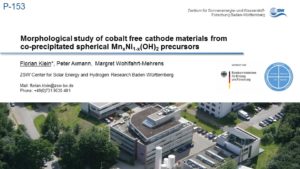Summary:
Lithium-ion batteries are currently the most important electrochemical energy storage systems for electric vehicles and intermediate storage of renewable energies. Forecasts indicate a dramatic increase in the storage demand for the next decades, associated directly with an increasing demand in the respective raw materials. Lithium, cobalt and natural graphite are already listed as critical raw materials.[1]
Layered oxides like NCMs are the most prominent cathode materials for lithium-ion batteries of today. The development target is to decrease the cobalt content. This measure helps to reduce both cost and the usage of critical raw materials, simultaneously increasing energy density due to higher storage capacity with cobalt-free materials as final target.[2] Additionally, the availability of nickel might develop the next bottleneck and should be take into account in the future.
Besides the chemical composition, both the morphology and structure of the cathode materials have an additional strong impact on the material performance and the energy density.[3] In our work, we will describe cobalt-free layered oxides with reduced nickel content. Consequently, we investigated the influence of the particle morphology and the crystallite size on the electrochemical performance of the lithium-nickel-manganese-oxides, synthesized via lithiation and calcination of a spherical hydroxide precursor. The oxides were characterized by XRD, ICP-OES and SEM. The electrochemical performance was investigated using coin cells with a lithium metal counter electrode and a potential range between 2.5 and 4.7 V.
The morphological differences and their influence on the electrochemical performance will be discussed, in order to gain a deeper understanding of the relationship between the thermal treatment conditions, the morphology of the particles and the crystallite size.
References
[1] S. Ziemann, A. Grunwald, L. Schebek, D. B. Müller, M. Weil, Rev. Metall. 2013, 110, 47.
[2] N. Voronina, Y.-K. Sun, S.-T. Myung, ACS Energy Lett. 2020, 5, 1814.
[3] P. Axmann, G. Gabrielli, M. Wohlfahrt-Mehrens, J. Power Sources 2016, 301, 151.
Acknowledgements
This work was supported in the project ExcellBattMat (03XP0257A) by the German Federal Ministry of Education and Research (BMBF).
We are happy to forward your request / feedback.

